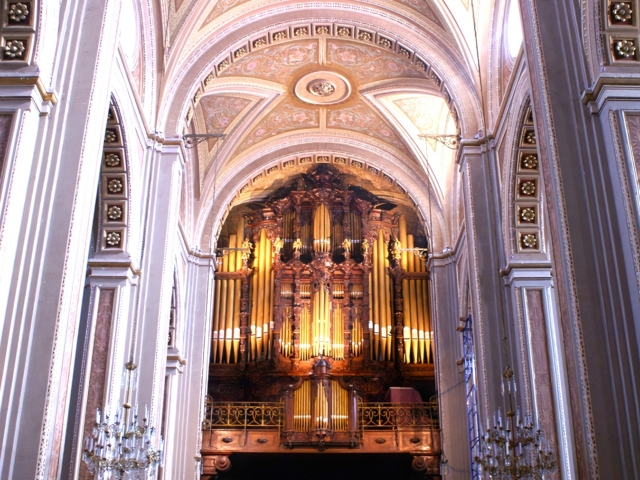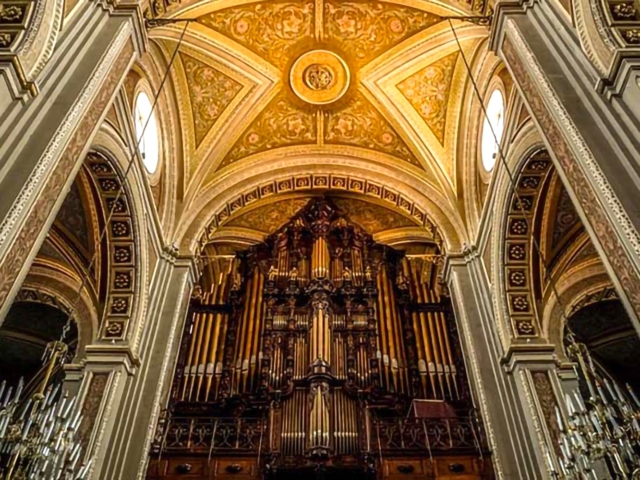
Adress
Av Francisco I. Madero Pte. S/N, Centro, 58000 Morelia, Michoacán. México.
GPS
19.702233419613, -101.19232177734
Phone
Send an Email to
Web
Monday
06:00 – 20:00
Tuesday
06:00 – 20:00
Wednesday
06:00 – 20:00
Thursday
06:00 – 20:00
Friday
06:00 – 20:00
Saturday
06:00 – 20:00
Sunday
06:00 – 20:00
KNOW MORE PLACES
VISITA OTRAS LOCALIDADES
Basic chronology
- 1537.- On September 20, it was decreed by royal decree that [the cathedral seat] “be built in a convenient place in the bishopric of Mechuacan.”
- 1539.- Construction began in Tzintzuntzan.
- 1540.- He moved to Pátzcuaro, which was then a neighborhood of Tzintzuntzan.
- 1580.- On November 9, his transfer to the young city of Valladolid was decreed by the bishop in office.
- 1584/1585.- The primitive cathedral caught fire, leaving it in very poor condition.
- 1642.- The construction of a new cathedral was requested, as the current one was insufficient.
- 1660.- On August 6, the construction of the current cathedral began by the architect Vicente Barroso de la Escayola. The first stone was laid by Bishop Fray Marcos Ramírez.
- 1704.- The cathedral was dedicated, despite not being finished, since it was urgent to demolish the remains of the first one.
- 1745.- The construction work was completed and its consecration was celebrated.
- 1854.- The fence was placed around the building.
- 1904.- The current organ, called San Gregorio Magno, one of the best on the continent, was installed.
- 1914/1917.- During these years the government took charge of part of the cathedral archive, which is located in the “Manuel Castañeda” archive of the Casa de Morelos Site Museum.
- 1956.- On August 27 of this year, a decree was issued declaring the Cathedral untouchable for its architecture and history.
- 1993.- Minor repair work completed.
- 2003.- The new stage lighting of the Cathedral was inaugurated. It takes place on Saturdays at 8:45pm, and on special occasions. It is accompanied by music and fireworks, and is a major attraction in Morelia.
The Catholic temple par excellence in Morelia is the cathedral. It can be seen from almost any point in the urban area, standing out among all the buildings for its height, its position in the valley, its pink stonework and its superb architecture. It is worth noting that the history of this building, as a material work, had ups and downs, and as a chair or seat of the bishopric, today an archbishopric, it was even more eventful.
History and evolution of the Cathedral of Valladolid Morelia
Since its origins, the Morelia Cathedral has witnessed a rich history and a fascinating architectural evolution.
The first steps of the bishopric In 1534, Charles I of Spain showed interest in establishing a bishopric in Michoacán. Finally, in 1536, Pope Paul III erected the bishopric and designated Tzintzuntzan as its initial seat. However, the first bishop appointed, Fray Luis de Fuensalida, declined the appointment, and it was Vasco de Quiroga who took his place in 1538.
De Tzintzuntzan a Pátzcuaro The first cathedral was the Church of San Francisco in Tzintzuntzan. However, due to local resistance and the preferences of Bishop Quiroga, the seat was moved to Pátzcuaro between 1539 and 1540. There, construction began on the Church of San Salvador, now the Basilica of Our Lady of Health.
Problems and decisions In 1546, under the direction of Toribio de Alcaraz, construction began on the Church of San Salvador in Pátzcuaro. However, problems with seismic activity and the subsoil interrupted the work, eventually leading to the decision to move the headquarters to Guayangareo (later known as Valladolid).
New headquarters in Valladolid In 1571, the transfer of the cathedral seat to Valladolid was approved, although the cocoliztli epidemic delayed the project until 1577. The first cathedral of Valladolid, built with modest materials such as adobe and wood, faced several problems, including a fire in 1584 that caused serious damage.
Over the years, Morelia Cathedral has evolved from humble beginnings into a stunning work of architecture, reflecting influences from the Renaissance and Baroque. This development not only showcases adaptability and innovation, but also the rich cultural and religious heritage of the region.
Construction of the current Cathedral of Morelia
The history of the current Cathedral of Morelia is as majestic as its architecture. In 1655, the King of Spain allocated a specific budget for the construction of a permanent cathedral in Michoacán. In 1656, the viceroy was ordered to appoint an architect, and so, on February 10, 1658, Vicente Barroso de la Escayola was appointed Master Builder, in charge of designing the plans.
Start of construction
- 1658: Vicente Barroso de la Escayola began to supervise the work. In 1660, the project was approved after a series of corrections. On 6 August 1660, in a solemn ceremony, the first stone was laid.
- Collaborators: Barroso de la Escayola worked on it until his death in 1692. Later, other architects such as Antonio de Chavira, Pedro Nolasco de Guedea, Juan de Silva y Carrillo, and Lucas Durán continued the work. Finally, the master from Puebla, José de Medina, completed it in 1744.
Dedication and Completion
The cathedral was dedicated on May 10, 1705, although the portals and towers were still missing. Due to the deterioration of the old cathedral, it was decided to use the new structure and abandon the old one. Finally, the cathedral was completed in 1744.
Structure and design
The cathedral is notable for its tripartite Baroque façade, decorated with sculptures and bas-reliefs depicting the Resurrection, the Adoration of the Shepherds and the Adoration of the Magi. It also houses statues of St. Peter, St. Paul, St. John the Baptist, St. Michael the Archangel, St. Agatha and St. Rose of Lima. The cathedral has a Latin cross layout, with two 62-metre-high towers.
Interior and treasure
Inside, the cathedral has four attached chapels, a canopy on the main altar that houses the silver baptismal font, and a choir decorated with a landscape of Morelia. The baptismal font is made of silver and is neoclassical in style. Among its greatest treasures are the sculpture of the Lord of the Sacristy from the 16th century and paintings by the Oaxacan painter Miguel Cabrera. The monumental organ, of German manufacture and with 4,600 voices, dates from 1907 and is the centerpiece of the Morelia International Organ Festival.
Today, the cathedral is illuminated at night, enhancing its beauty and grandeur for all visitors.
Other temples that served as cathedral headquarters in Michoacán from the 16th to the 18th century
1. The Temple of San Francisco de Tzintzuntzan from 1538 to 1540, approximately.
2. The Temple of San Francisco de Pátzcuaro, which later became the headquarters of the Jesuit brothers, from 1540 to 1565, when one of the naves of the unfinished Cathedral of San Salvador was completed, today the Basilica of Our Lady of Health of Pátzcuaro.
3. The primitive Cathedral of Valladolid, from 1580 to 1705, the year in which the new and current Metropolitan Cathedral was dedicated for the first time, to move the chapter and the cathedral headquarters to it.


















